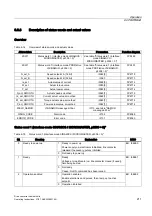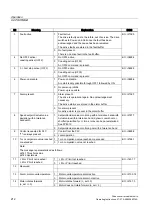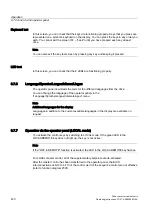
Operation
6.7 Control via the operator panel
Drive converter cabinet units
222
Operating Instructions, 07/07, A5E00288214A
The following DOs are available in the S150:
•
CU:
General parameters for the Control Unit (CU320)
•
VECTOR:
Drive control
•
A_INF
Regulated infeed
•
TM31:
Terminal Module TM31
Parameters with identical functions may exist with the same parameter number in more than
one DO (e.g. p0002).
The AOP30 is used for operating devices that comprise more than one drive (in this respect,
a regulated infeed is also a "drive") so that attention is focused on one drive (i.e. the
"current" drive). You can switch between the drives either in the operation screen or in the
main menu. The corresponding function key is labeled "Drive".
This drive determines the following:
●
Operation screen
●
Fault and alarm displays
●
The controller (ON, OFF, …) of a drive
Depending on your requirements, you can choose between two AOP display types:
1.
All parameters
All the parameters present in the device are listed here. The DO to which the parameter
currently selected belongs (inverted) is displayed in curly brackets in the top left of the
screen.
2.
DO selection
In this display, you can pre-select a DO Only the parameters for this DO are then listed.
(The expert list display in STARTER only uses this DO view)
In both cases, the set access level governs which parameters are displayed. You can set the
access level in the menu for inhibit functions, which can be called up using the key button.
The parameters for access levels 1 and 2 are sufficient for simple applications.
At access level 3 (experts), you can change the structure of the function by interconnecting
BICO parameters.
In the data set selection menu, you can choose which of the data sets chosen is currently
DISPLAYED.
Data set parameters are indicated by a "c", "d", "m", "e", or "p" between the parameter
number and parameter designator. The first line from the top (aligned right) shows which
data sets are currently displayed.
When a data set parameter is changed, the data set selection dialog appears.
)
)
)
)
)
F
G
P
$23
7\SH
0D[
'ULYH
'DWDEORFNVHOHFWLRQ
&RPPDQG'%
'ULYH'%
0RWRU'%
+HOS
%DFN
2.
Figure 6-28 Selecting data sets















































